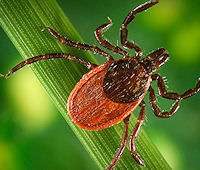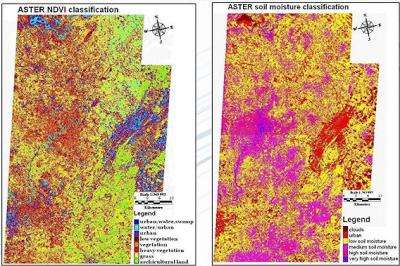Tracking Ticks via Satellite

Finding a tick usually involves a squeamish self-examination - carefully rubbing fingertips through the scalp, meticulously scanning the body, and groaning "eyeww" if a little bloodsucker is discovered.
Now, there's a new way to find the pesky, disease-laden critters--via satellite!
University of Alabama at Birmingham graduate students Nathan Renneboog and Stephen Firsing are pioneering the new technique as part of a NASA program called DEVELOP. They've been using satellite images of Alabama's Talladega National Forest to reveal areas of the forest where ticks likely flourish.
Knowing tick whereabouts is important. Ticks can deliver some very unwelcome visitors into your bloodstream: the toxins and organisms that cause Rocky Mountain Spotted Fever, Southern Tick Associated Rash Illness, and Lyme Disease.
"Our goal was to identify high-risk zones for these diseases," explains Renneboog. "We know that ticks prefer moist, heavily vegetated areas, so we wanted to map those areas."
Tick hosts include white-tailed deer, white-footed mice, and you. Lurking like mini-vampires, ticks wait for one of these unsuspecting passersby on whom to feast. Without blood meals, ticks die. Some ticks' saliva contains a blood thinner to make it easier for them to feed. The saliva may also contain neurotoxins that keep you from feeling pain as the tick digs its barbed mouth into your skin and enjoys a meal at your expense.

Dr. Jeff Luvall of NASA's Marshall Space Flight Center mentored Renneboog and Firsing in their tick hunt, which took place in UAB's Laboratory for Global Health Observation. "I taught the students how to use infrared images from an instrument on the Terra satellite to analyze soil moisture and vegetation."
The two students used what they learned from their NASA advisor to classify levels of vegetation and moisture in 12 locations in the forest. They then created detailed digital maps and images showing likely tick habitats - areas where dense vegetation overlapped those with high soil moisture.
To confirm that the maps were accurate, Renneboog and Firsing needed some old-fashioned, ground-level tick counts for comparison. They used data provided by Jacksonville State University faculty and students, who collected ticks by dragging large white clothes through bushes and grasses. They actually counted the ticks by hand and identified their species.
"One of our aims for this study is to raise awareness about ticks - where they live, how they behave, what diseases they carry," adds Firsing. "For example, it's not widely known that there's Lyme disease in Alabama now. But there is and has been for a while. The first case was actually documented in this state in 1986."
As part of their DEVELOP project, Renneboog and Firsing do outreach work, presenting their findings at conferences and talking to the public. This summer, for instance, they'll work with Girl Scout Troops.
"We'll teach them to use repellents, wear long pants, tuck in their shirt, and wear socks when they go into the woods," says Renneboog.
"And we'll teach them how to properly remove a tick if it latches onto them," adds Firsing. "You need to use tweezers. If you try to pinch the tick's body with your finger tips and pull the tick off, you'll squeeze it, and the tick will regurgitate the contents of its gut into your bloodstream."
Eyeww!
"That's how they infect you," he says.
Bring on the satellites.
Source: Science@NASA, by Dauna Coulter


















